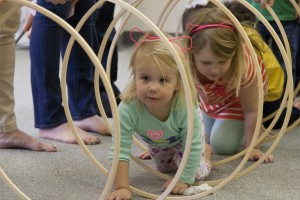What are your biggest behavior challenges? Fidgety kids? Disruptive outbursts? Parents who seem oblivious to their child’s charming antics?
Last month, we asked Musikgarten teachers for their best advice on classroom management and dealing with disruptive behaviors. The number of responses was overwhelming, so we’ll tackle this topic as a two-part series. This month, we’ll address behavior issues; next month we’ll cover clever classroom management methods.
Let’s talk behavior problems! When it comes to behavior, it’s not that kids are either good or bad. All children act up from time-to-time, some more than others. It helps to understand why kids act out:
- They’re tired or hungry
- They’re not used to participating in structured or group activities and don’t know “the rules” yet
- They’re shy, nervous, or feeling insecure
- They want attention
- They’re not ready for a class just yet; children mature at different rates
- They may have a special needs, such as autism, ADHD, or a behavioral, neurological or sensory processing disorder
Remember, it’s your studio, your rules, and a little structure goes a long way toward making sure parents and children have the best experience possible.
A few Do’s and Don’ts when it comes to behavior issues:
- Do let families know your class expectations from day one. Hang a poster. Post class rules on your website. Remind children often or ask them to remind you of the rules.
- Do address severe or ongoing behavior problems promptly and privately with the child’s parent after class. The longer you let a problem persist, the tougher it will be to correct.
- Do let parents know you want to work with them to help their child have the best experience and get the most from your class
“Parent cooperation only comes out of good relationships with the families you serve. Good working relationships, where the people know that you care, are the first step in handling any misbehavior.” – Robin Bishop, HappyHeart Musikgarten
- Don’t ask if, imply or suggest a child has special needs such as ADHD or autism – those are specific medical diagnoses that should only be made by qualified professionals.
- Do reward good behavior openly and often. Let other children set an example.
- Do politely ask a parent to temporarily remove an unruly child to help them calm down.
- Do try to understand why a child may be acting up and work with parents to find a solution. If a child is always cranky during a mid-morning class, he may just need a nap at that time and a later class.
Now, some tips from real Musikgarten teachers!
- Great Behavior Begins with Mom & Dad! “It all begins with parent education. At the very first class of each semester, I go over what parents can expect from their child and how I would like the parents to participate. I want the parents to model what I do, and the children will learn from them. I tell parents all children participate differently in class: some will just watch, some will be active elsewhere in the room, etc. I continually remind parents of these ideas through out the semester.” – Jennifer Anderson, Music Time Studio
- Call on Mom or Dad. If a child starts crying, screaming, or melting down during a class, take a note from Kendra Beagles of KB’s Musik and address it directly to the parent. She’ll politely say, “You’re welcome to take Suzy to the bathroom if she needs a break. Please come back and join us as soon as she’s calm.” Make sure the parent knows you’re encouraging a brief cool down for the child, not asking them to leave.
- Use Body Language. No child likes to be reprimanded in front of a class. And as a teacher, you don’t want to interrupt a song or dance. Try this: Stand up and deliberately position yourself next to the child or in between the children being disruptive. “By moving yourself and continuing the song, you show them that you’re not going to let their behavior interrupt the activity that the others are enjoying.” – Shannon May, Apple Tree Arts
- Stop Disruptions Before They Start. “My studio is as free from distractions as possible. There is nothing for the kids to get into. There are very few “no’s” in my studio. I save “no” for when something is a danger to the child or someone else (e.g. hitting or throwing instruments).” – Jennifer Anderson, Music Time Studio
- Call Out Good Recognize children who are following directions with verbal praise and positive attention. Say, “I really like how Mason and Ella and Audrey are sitting in the circle. Who else can sit in the circle? Good!”
- Redirect Unwanted Attention. Use the child’s name and clearly remind, invite, and encourage him or her toward the positive and desired behavior. Offer praise when they follow directions. For example, “Claire, we need you over here to help us sing this song. Thank you!” or “Jacob, show us how you make circles with the scarves. That’s right! Who else can make circles like Jacob?”
- Teach Children to Respect Instruments. We love this input from Kendra Beagles, because it incorporates three important behavior management concepts: 1) Set expectations 2) Follow though with consequences 3) Positively reinforce the desired behavior. “Set children up for success before passing out instruments so they know how to treat them with care. Before I pass out rhythm sticks, I announce ‘Who can tell me what happens if you throw your sticks?’ The children reply, ‘Mrs. B gets them!’ If a child does throw the sticks, I immediately go pick up the sticks and say ‘Wow! I have more sticks to play with now!’ I then place the sticks on the floor behind my back. This lets children know I mean what I say and will follow through with my actions. The child will usually pout or cry, but I continue with my class activity. After a few minutes I’ll motion for the child to come get his/her sticks. If they throw them again, I take them and don’t give them back. At the end of class I’ll go over to the child and let them know that I enjoy having them in my music class and am very pleased when they respect my instruments.” – Kendra Beagles, KB’s Musik
- Offer Simple Choices. Very young children have a difficult time with open-ended questions such as “Where do you want to sit?” or “What should you do?” This can frustrate them and exacerbate the disruption. Instead, give them a very simple either/or option. For example, to let a child know running around is not an option, you can ask, “Do you want to sit on Mommy’s lap or mine?” or “You may join us in the circle or sit over there.” – tip courtesy of Jane Burlinson, Coastal School of Music
Wait, there’s more! Stay tuned for Part 2 next month, where we share teachers’ top classroom management tips to keep things running smoothly (even large classes).
Thank you to our awesome contributing teachers for their time, talent, and wisdom!
- Jennifer Anderson, Music Time Studio
- Shannon May, Apple Tree Arts
- Ann Engberg, Hunterdon Academy of the Arts
- Jane Burlinson, Coastal School of Music
- Robin Bishop, HappyHeart Musikgarten
- Kendra Beagles, KB’s Musik
- Bobbi Morgan
What do you think? Share your questions, thoughts, ideas, and advice with us here.







